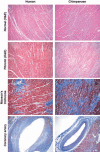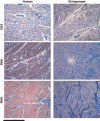Heart disease is common in humans and chimpanzees, but is caused by different pathological processes
- PMID: 25567850
- PMCID: PMC3352420
- DOI: 10.1111/j.1752-4571.2008.00064.x
Heart disease is common in humans and chimpanzees, but is caused by different pathological processes
Abstract
Heart disease is common in both humans and chimpanzees, manifesting typically as sudden cardiac arrest or progressive heart failure. Surprisingly, although chimpanzees are our closest evolutionary relatives, the major cause of heart disease is different in the two species. Histopathology data of affected chimpanzee hearts from two primate centers, and analysis of literature indicate that sudden death in chimpanzees (and in gorillas and orangutans) is commonly associated with diffuse interstitial myocardial fibrosis of unknown cause. In contrast, most human heart disease results from coronary artery atherosclerosis, which occludes myocardial blood supply, causing ischemic damage. The typical myocardial infarction of humans due to coronary artery thrombosis is rare in these apes, despite their human-like coronary-risk-prone blood lipid profiles. Instead, chimpanzee 'heart attacks' are likely due to arrythmias triggered by myocardial fibrosis. Why do humans not often suffer from the fibrotic heart disease so common in our closest evolutionary cousins? Conversely, why do chimpanzees not have the kind of heart disease so common in humans? The answers could be of value to medical care, as well as to understanding human evolution. A preliminary attempt is made to explore possibilities at the histological level, with a focus on glycosylation changes.
Keywords: atherosclerosis; evolution; great ape; heart attacks; heart disease; heart failure; hominids; myocardial fibrosis.
Figures




References
-
- Abbott RD, Garrison RJ, Wilson PW, Epstein FH, Castelli WP, Feinleib M, LaRue C. Joint distribution of lipoprotein cholesterol classes. The Framingham study. Arteriosclerosis. 1983;3:260–272. - PubMed
-
- Binder CJ, Chang MK, Shaw PX, Miller YI, Hartvigsen K, et al. Innate and acquired immunity in atherogenesis. Nature Medicine. 2002;8:1218–1226. - PubMed
-
- Binder CJ, Shaw PX, Chang MK, Boullier A, Hartvigsen K, et al. The role of natural antibodies in atherogenesis. Journal of Lipid Research. 2005;46:1353–1363. - PubMed
-
- Blaton V, Peeters H. The nonhuman primates as models for studying human atherosclerosis: studies on the chimpanzee, the baboon and the rhesus macacus. Advances in Experimental Medicine and Biology. 1976;67:33–64. - PubMed
Grants and funding
LinkOut - more resources
Full Text Sources
Research Materials
Miscellaneous

